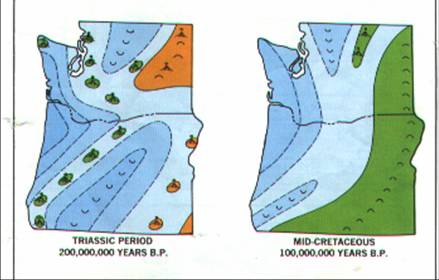

Oregon History




| Sea floor
subduction yields the scraping for coastal ranges and these are paralleled by
a series of volcanoes. As the Cascades today parallel the coast range so 200
mya did volcanoes parallel the coastal ranges of that time. These volcanoes
are now eroded. The evidence of old volcanic include granitic masses. Why?
Old molten magmas moving up through sediments (coastal) from deep below the
surface melt the sediments, mix, change melting point, and the new magma has
a more graniitc mix. As the magma erupts, one gets an andesite – as it cools
below you get a settling of crystals and differential crystallization
yielding a more granitic/dioritic rock. So masses of granitic rock are the
remnants of the great magma reservoirs of the former Cascades. Also old
sediments are composed of volcanic debris. |
|
| This situation
lasted from between 200 mya to about 150 mya up until about 30 mya (through
the Mesozoic and beyond). The seafloor moved toward the continent and
everything marched to the sea. The continent built out as the seafloor was
subducted. As the coastal range moved out so too did the volcanic chain. The
chain of coastal mountains is buried today under more recent volcanism.
Remnants high enough yet to see are in
the Blue, Wallowa, and Klamath mountains. The bay out to the west of the then
coastal range accumulated sediment from the range. |